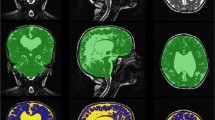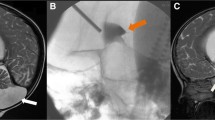Abstract
Objective
To develop automated deformation modelling for the assessment of cerebrospinal fluid (CSF) local volume changes in patients with hydrocephalus treated by surgery.
Methods
Ventricular and subarachnoid CSF volume changes were mapped by calculating the Jacobian determinant of the deformation fields obtained after non-linear registration of pre- and postoperative images. A total of 31 consecutive patients, 15 with communicating hydrocephalus (CH) and 16 with non-communicating hydrocephalus (NCH), were investigated before and after surgery using a 3D SPACE (sampling perfection with application optimised contrast using different flip-angle evolution) sequence. Two readers assessed CSF volume changes using 3D colour-encoded maps. The Evans index and postoperative volume changes of the lateral ventricles and sylvian fissures were quantified and statistically compared.
Results
Before surgery, sylvian fissure and brain ventricle volume differed significantly between CH and NCH (P = 0.001 and P = 0.025, respectively). After surgery, 3D colour-encoded maps allowed for the visual recognition of the CSF volume changes in all patients. The amounts of ventricle volume loss of CH and NCH patients were not significantly different (P = 0.30), whereas readjustment of the sylvian fissure volume was conflicting in CH and NCH patients (P < 0.001). The Evans index correlated with ventricle volume in NCH patients.
Conclusion
3D mapping of CSF volume changes is feasible providing a quantitative follow-up of patients with hydrocephalus.
Key Points
• MRI can provide helpful information about cerebrospinal fluid volumes.
• 3D CSF mapping allows quantitative follow-up in communicating and non-communicating hydrocephalus.
• Following intervention, fissures and cisterns readjust in both forms of hydrocephalus.
• These findings support the hypothesis of suprasylvian block in communicating hydrocephalus.
• 3D mapping may improve shunt dysfunction detection and guide valve pressure settings.





Similar content being viewed by others
Abbreviations
- CH:
-
communicating hydrocephalus
- CSF:
-
cerebrospinal fluid
- ETV:
-
endoscopic third ventriculostomy
- NCH:
-
non-communicating hydrocephalus
- SPACE:
-
sampling perfection with application optimised contrast using different flip-angle evolution
References
Anderson RC, Grant JJ, de la Paz R et al (2002) Volumetric measurements in the detection of reduced ventricular volume in patients with normal-pressure hydrocephalus whose clinical condition improved after ventriculoperitoneal shunt placement. J Neurosurg 97:73–79
McConnell KA, Zou KH, Chabrerie AV et al (2004) Decreases in ventricular volume correlate with decreases in ventricular pressure in idiopathic normal pressure hydrocephalus patients who experienced clinical improvement after implantation with adjustable valve shunts. Neurosurgery 55:582–592
Buxton N, Turner B, Ramli N et al (2002) Changes in third ventricular size with neuroendoscopic third ventriculostomy: a blinded study. J Neurol Neurosurg Psychiatry 72:385–387
Kulkarni AV, Drake JM, Armstrong DC et al (2000) Imaging correlates of successful endoscopic third ventriculostomy. J Neurosurg 92:915–919
Schwartz TH, Ho B, Prestigiacomo CJ et al (1999) Ventricular volume following third ventriculostomy. J Neurosurg 91:20–25
St George E, Natarajan K, Sgouros S (2004) Changes in ventricular volume in hydrocephalic children following successful endoscopic third ventriculostomy. Child’s nervous system. ChNS 20:834–838
Chetelat G, Landeau B, Eustache F et al (2005) Using voxel-based morphometry to map the structural changes associated with rapid conversion in MCI: a longitudinal MRI study. NeuroImage 27:934–946
Fox NC, Crum WR, Scahill RI et al (2001) Imaging of onset and progression of Alzheimer’s disease with voxel-compression mapping of serial magnetic resonance images. Lancet 358:201–205
Janke AL, de Zubicaray G, Rose SE et al (2001) 4D deformation modeling of cortical disease progression in Alzheimer’s dementia. Magn Reson Med 46:661–666
Thompson PM, Hayashi KM, de Zubicaray G et al (2003) Dynamics of gray matter loss in Alzheimer’s disease. J Neurosci 23:994–1005
Hodel J, Silvera J, Bekaert O et al (2011) Intracranial cerebrospinal fluid spaces imaging using a pulse-triggered three-dimensional turbo spin echo MR sequence with variable flip-angle distribution. Eur Radiol 21:402–410
Relkin N, Marmarou A, Klinge P et al (2005) Diagnosing idiopathic normal-pressure hydrocephalus. Neurosurgery 57:4–16
Lemieux L, Hammers A, Mackinnon T et al (2003) Automatic segmentation of the brain and intracranial cerebrospinal fluid in T1-weighted volume MRI scans of the head, and its application to serial cerebral and intracranial volumetry. Magn Reson Med 49:872–884
Fonov V, Evans AC, Botteron K et al (2011) Unbiased average age-appropriate atlases for pediatric studies. NeuroImage 54:313–327
Boyes RG, Rueckert D, Aljabar P et al (2006) Cerebral atrophy measurements using Jacobian integration: comparison with the boundary shift integral. NeuroImage 32:159–169
Rekate HL, Nadkarni TD, Wallace D (2008) The importance of the cortical subarachnoid space in understanding hydrocephalus. J Neurosurg Pediatr 2:1–11
Kitagaki H, Mori E, Ishii K et al (1998) CSF spaces in idiopathic normal pressure hydrocephalus: morphology and volumetry. AJNR Am J Neuroradiol 19:1277–1284
Tsunoda A, Mitsuoka H, Sato K et al (2000) A quantitative index of intracranial cerebrospinal fluid distribution in normal pressure hydrocephalus using an MRI-based processing technique. Neuroradiology 42:424–429
Bellotti A, Rapana A, Iaccarino C et al (2001) Intracranial pressure monitoring after endoscopic third ventriculostomy: an effective method to manage the ‘adaptation period’. Clin Neurol Neurosurg 103:223–227
Author information
Authors and Affiliations
Corresponding author
Rights and permissions
About this article
Cite this article
Hodel, J., Besson, P., Rahmouni, A. et al. 3D mapping of cerebrospinal fluid local volume changes in patients with hydrocephalus treated by surgery: preliminary study. Eur Radiol 24, 136–142 (2014). https://doi.org/10.1007/s00330-013-2990-z
Received:
Revised:
Accepted:
Published:
Issue Date:
DOI: https://doi.org/10.1007/s00330-013-2990-z




